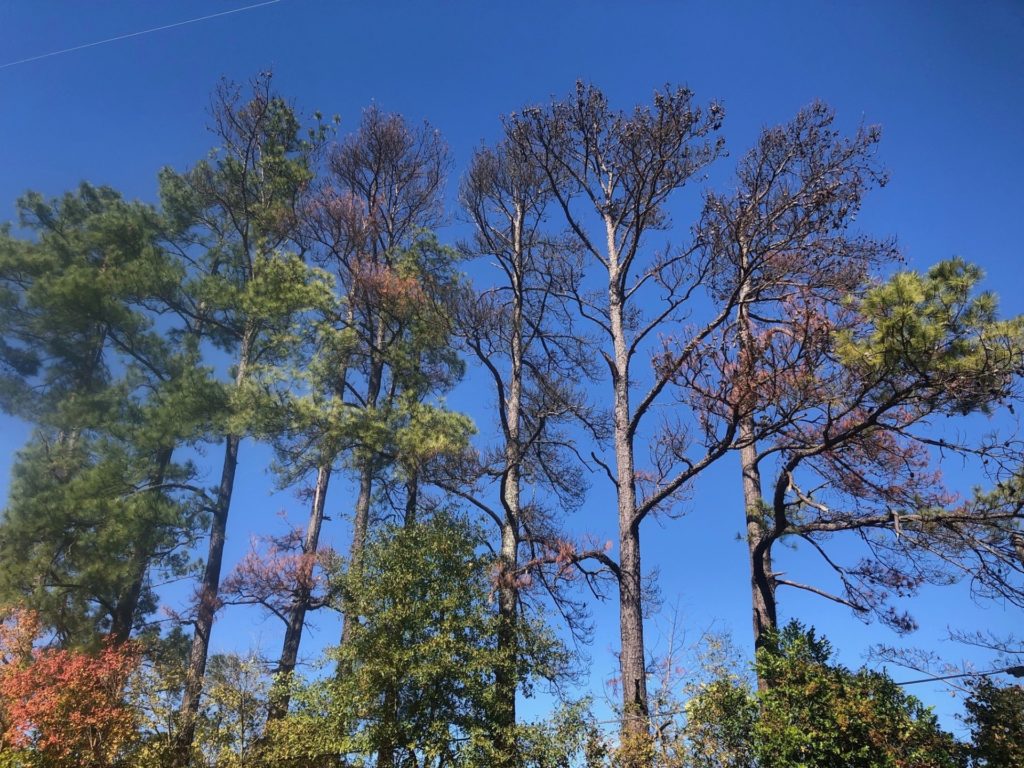Continued Winter Storm Uri tree impacts – pine tree mortality
Stressed pine trees under attack by beetles
February 2021 will be remembered by Texans and by our trees as the year of the “Deep Freeze.” Even now, more than nine months removed from Winter Storm Uri, Texans are still seeing the effects of the “Deep Freeze.”
Multiple days with below-freezing temperatures resulted in the crowns of a noticeable number of trees turning brown and appearing as if the trees had died. As the Texas A&M Forest Service reported earlier in the year, many, if not most, of those trees recovered and produced normal levels of foliage during the summer.
However, a recently observed effect is mortality in pine trees caused by Ips engraver beetles. These native insects, of which there are three species in East Texas, may attack healthy and stressed trees alike. Usually, they can successfully invade only severely stressed pine trees, such as those recovering from a hard freeze.
Beetle attacks
Allen Smith, Texas A&M Forest Service regional forest health coordinator, has inspected many tracts in East Texas this fall and has seen a large amount of pine tree mortality caused by Ips engraver beetles.
“Looking back at the past nine months, the fact that these beetles are now taking center stage in the decline and death of our pine trees is inevitable,” said Smith. “Uri was a major stressor of trees, and the following extended droughty conditions throughout the pine regions of East Texas added additional stress.”
These combined stress factors weaken trees’ natural defenses against all pests, including Ips beetles. As a result, even small-scale Ips beetle attacks successfully overwhelmed and killed individual trees.
Soon after adult beetles are attracted to and land on a stressed tree, they mate. The resulting developing larvae excavate tunnels or galleries under the bark, which, in sufficient numbers, essentially girdles the tree and disrupts the tree’s vascular system.
“Death can occur quickly and is often measured in days, not weeks,” said Smith. “Along with Ips beetles, inspected trees are showing evidence of ambrosia beetles and southern pine sawyer beetles. The common trait among these beetle types is that they are all attracted to stressed pines.”
Typically, Ips beetle attacks are characterized by the presence of pitch tubes scattered about the bark. Pitch tubes, which look like popped popcorn, are formed as the trees try to prevent entry by pushing sap into the entry hole made by the beetle.
Recently observed trees show uncharacteristically small, desiccated pitch tubes, if they are present at all, indicating the lack of sap production and moisture inside the tree. When the bark is scraped to inspect beetle galleries, the exposed phloem—the region where sap flow occurs— is noticeably dry, indicating severe stress.
Managing the damage
So, what can be done? Usually, forests are managed to prevent bark beetles, including Ips beetles, by using a combination of well-timed thinnings and competition control treatments to promote tree vigor and overall stand health. In extreme cases such as the “Deep Freeze,” not much more can be done except to prepare for the next emergence of beetles in the spring.
Standing beetle-killed trees should be removed and burned or otherwise disposed of to prevent the emergence of beetles from the felled trees. If the bark has not yet begun to slip on enough beetle-killed trees to attract a service provider to the site, the trees may be salvaged and taken to market, providing some recovery of financial loss for the landowner.
With winter approaching, the Ips beetles will overwinter in trees, meaning they will emerge in 2022 with the start of spring. The best-case scenario for pine trees is to have wet weather this winter so that trees have good soil moisture when they start growing again.
For more information on pine trees in your area, contact your local forester at https://tfsweb.tamu.edu/ContactUs/.



